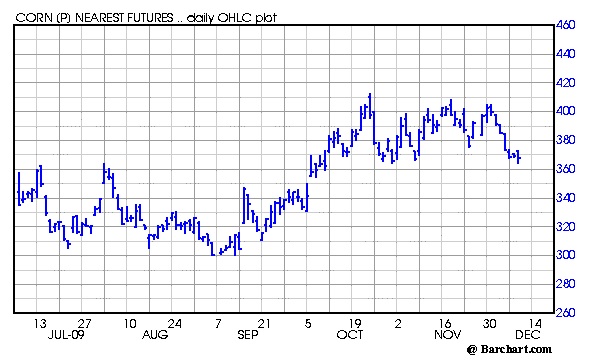2010 Market Commentary
LOOKING AHEAD AT THE YEAR FOR CORN, SOYBEAN AND WHEAT MARKETS
Rising Loonie: Two Sides of the Coin
The steady appreciation of the Canadian dollar against the faltering US dollar has been both beneficial and detrimental to grain producers in Ontario.
The rise of the loonie, as of December 14, 2009 (see table 1), makes Canadian grain more expensive for export buyers, thus placing downward pressure on local prices. This comes at a time when North American grain is generally considered overpriced compared with world values as evidenced by Egypt and Middle Eastern buyers choosing to purchase Eastern European wheat over US or Canadian wheat.
Table 1. Canadian Dollar Nearest Futures

However, at the same time, the depreciation of the US dollar, and more importantly the threat of continued depreciation or even collapse of the US currency, has benefited grain commodities. Investment funds and speculators are increasingly choosing to invest in commodities rather than the US dollar. This is a reversal of the traditional role of the US dollar as a ‘safe haven.’
Gold is considered the safest commodity in which to park money. However grain commodities have grown in popularity in recent months as they are coming off a very low base compared with gold and oil which have less room for growth.
On the balance, growers have benefited from the appreciating loonie, with local prices rising. Whether local prices continue to benefit from the loonie’s rise will depend on whether the panic buying of commodity futures continues and whether the fundamentals in the grain market catch up to the speculative buying.
Prices will always return to their fundamental value, for a strong reminder of this, one only needs to look at 2007-08.
Corn Market Commentary
Global
Global consumption is expected to outweigh supply in 2009-10 resulting in lower ending stocks as displayed in table 2. Ethanol margins have improved markedly in the last few months, prompting analysts to increase their ethanol demand estimates for corn. This increased demand will require three to four million additional acres of corn to be planted in the US in 2010. However, with soybean futures performing well, the trade is unsure if such an acreage switch is realistic.
Table 2. Corn Global Supply & Demand

The trade is watching the fate of the remaining unharvested corn in the US closely. Depending on the weather, some of this corn may not enter the supply chain.
New crop corn prices are considered overvalued (see table 3). However, corn fundamentals are perceived to have more upside potential than wheat and soybeans at this stage.
Table 3. Corn Futures

Local
The late onset of winter allowed most Ontario corn to be harvested. However, it is estimated that 10 to 20 percent of the 2009 crop will await harvest in the spring.
Despite high moisture levels, harvested corn does not appear to be showing above average levels of fusarium and mycotoxin. However, quality downgrades were observed primarily due to low test weight, as a result of crops failing to reach full maturity. Finding markets for the large amount of low quality corn looms as a challenge for producers.
Growers are being advised to take care when storing the corn crop which may contain more than 10 percent fine particles.
Soybean Market Commentary
Global
The failed 2008-09 crop in South America has left North America as the world’s only source of export soybeans. This window of opportunity has generated the fastest rate of old crop soybean export sales ever. Despite the front ended selling opportunities, carry has been developing in the mid 2010 contract (see table 4), on fears of a global shortage before the South American crop arrives.
The US is reporting record soybean crushing figures. However, the cold wet season has impacted on oil content, with crush yields dropping to the lowest levels since 2003. The lower than expected oil yield has triggered a sharp rise in oil prices.
The European Union (EU) is under pressure to weaken its import ban on genetically modified soybeans, as European livestock producers struggle to source stock feed.
Local
The 2008-09 soybean harvest was up 5.8 percent from the previous year, with record high harvested acres and a 7.4 percent decrease in average yield to 40.2 bushels per acre.
Ontario prices are lagging futures, with the basis being hit by the rising Canadian dollar. However prices remain in profitable territory.
Table 4. Soybean Market Carry

Wheat Market Commentary
Global
Global consumption is expected to increase next year with more wheat used for livestock feed expected in Russia, Israel, South Korea, and Morocco. However global ending stocks are projected higher as the increase in world output more than offsets lower carryover and the relatively small increase in consumption (see table 5).
Table 5. Wheat Global Supply & Demand

Wheat prices have been depressed for much of 2009 due to a worldwide oversupply. The late corn and soybean harvest, combined with low prices has greatly reduced the amount of wheat planted in North America, particularly soft red winter wheat.
Fears surrounding the falling US dollar inflated wheat futures during October and November creating a bubble between the futures price and the fundamentals. Very sluggish export sales have since pulled wheat futures back (see table 6).
Table 6. Wheat Futures

Local
Despite a frigid October, mild November weather has given Ontario wheat a better start to the season than expected. According to OMAFRA estimates, the winter wheat planted is comprised of 83 percent soft red winter, 10 percent hard red winter and seven percent soft white winter.
The Marketing Department of Grain Farmers of Ontario estimates 725,000 acres of wheat have been planted, down from last year’s total of 1.13 million acres. •

















